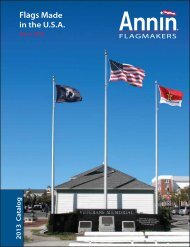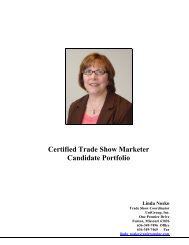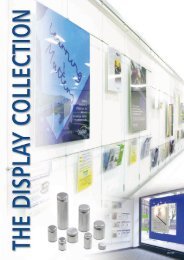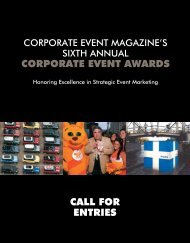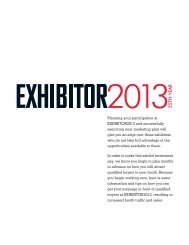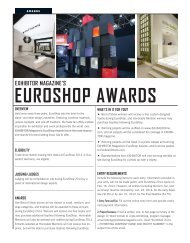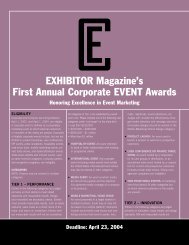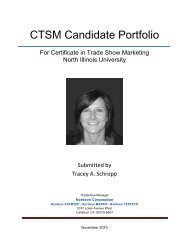You also want an ePaper? Increase the reach of your titles
YUMPU automatically turns print PDFs into web optimized ePapers that Google loves.
<strong>CTSM</strong> Candidate <strong>Portfolio</strong><br />
Melanie Swanson<br />
Marketing Events Manager<br />
Wacom Technology<br />
17300 NE 29 th St.<br />
Vancouver, WA 98682<br />
360-254-9992<br />
www.wacom.com<br />
swansonmj@aol.com<br />
<strong>CTSM</strong> Candidate <strong>Portfolio</strong><br />
Melanie Swanson<br />
Wacom Technology<br />
1
Table of Contents<br />
Vital Statistics<br />
1 Cover page—Candidate Name, Title, Company, and Contact Information<br />
2 Table of Contents<br />
3 Foreword<br />
Candidate Profile<br />
4 Company Background<br />
5 Wacom at a Glance<br />
Show Participation Information<br />
6 Wacom Year 2000 Trade Show Schedule<br />
7 Products Marketed at Trade Shows and their Target Markets<br />
8 Corporate Objectives for Trade Show Participation<br />
Management of Exhibit Design/Production<br />
9 Background<br />
Picture of Old Booth<br />
Process<br />
10 Comparison of Existing Booth versus Proposed New Booth<br />
Results<br />
Modifications<br />
11 Modifications, continued<br />
Picture of Proposed Booth<br />
Picture of Suggested Modifications<br />
12 Pictures of New Booth and Suggested Lighting Modifications<br />
Management of Integrated Marketing Communications to Support Trade Show<br />
Participation<br />
13 <strong>Example</strong> of Third-Party Sponsorship at a Trade Show<br />
Picture of Third-Party Participation at a Trade Show<br />
<strong>Example</strong> of a Pre-Show Marketing Direct Mail Campaign<br />
14 <strong>Example</strong> of the Use of a Promotional Giveaway Item<br />
Picture of a Promotional Giveaway Item<br />
<strong>Example</strong> of Use of the Internet to Promote Presence at Trade Shows<br />
Management of Results Reporting<br />
15 Chart of Year 2001 Trade Show Results and Explanation<br />
Miscellaneous<br />
16 Seybold San Francisco Pre-Show Meeting Presentation<br />
Picture of Hands-On Lab at Photoshop World Tampa<br />
Picture of Morale-Boosting T-shirt Given to Booth Staff<br />
Bibliography<br />
17 List of Exhibitor Show Seminars Referenced<br />
<strong>CTSM</strong> Candidate <strong>Portfolio</strong><br />
Melanie Swanson<br />
Wacom Technology<br />
2
Foreword<br />
Wacom Technology is a privately held corporation therefore complete financial data is not<br />
available.<br />
This portfolio encompasses samples of various aspects of exhibit management for Wacom<br />
Technology. Because the program has evolved so much within the last two years, there is not one<br />
single example given but rather a broad range of events are showcased to best highlight the<br />
development of the program. The <strong>CTSM</strong> courses completed over the last two years were<br />
instrumental in many of the improvements and new ideas used in Wacom’s trade show program.<br />
Samples of work included in this portfolio are show results, exhibit design modifications and<br />
additions, and promotions.<br />
Shortly after the completion of this portfolio, <strong>CTSM</strong> candidate Melanie Swanson resigned her<br />
position as Marketing Events Manager for Wacom Technology to relocate to Appleton, Wisconsin<br />
when her husband was transferred.<br />
Candidate Profile<br />
I joined Wacom in September of 1993 as a Marketing Assistant, where I was responsible for the<br />
company’s product evaluation program (sending graphics tablets to industry press contacts for<br />
editorial evaluation). I was also responsible for coordinating company events such as the annual<br />
summer picnic; annual family holiday party; participation in charity events such as the local<br />
March of Dimes Walk America; and semi-annual corporate meetings.<br />
In 1994 I began assisting Wacom’s Marketing Events Manager with trade show logistics. I was<br />
given the responsibility of interviewing and hiring artists and presenters who demonstrated<br />
Wacom’s graphics tablets at trade shows. Additional duties included managing booth staff<br />
schedules, working at the reception counter during trade shows, and coordinating travel<br />
arrangements for the show staff.<br />
I left Wacom in 1997 to join the launch and communications team at Hewlett Packard’s Printer<br />
and Scanner Marketing Center as a contract employee. The logistical, events and meeting<br />
planning skills I had learned at Wacom transferred well into the fast-paced DeskJet printer<br />
marketing environment. While I enjoyed my experience at HP, as a contract employee my tenure<br />
was limited to a 24-month term.<br />
Fortunately, near the end of my contract term at HP, there was an opening at Wacom, and I was<br />
welcomed back as the Marketing Events Manager in September of 1999. My duties include<br />
planning, selection, scheduling and execution of trade shows, seminars, distributor training<br />
events, and corporate events.<br />
I am pursuing a Bachelor of Arts degree in Personnel Psychology and Human Resource<br />
Management from Washington State University in Vancouver with an estimated completion date<br />
of May 2002. Prior to joining Wacom, I spent three years as a retail music store manager and five<br />
years as a fast-food restaurant manager.<br />
<strong>CTSM</strong> Candidate <strong>Portfolio</strong><br />
Melanie Swanson<br />
Wacom Technology<br />
3
Company Background:<br />
Wacom Technology Corporation, a wholly owned subsidiary of Wacom Company Limited in<br />
Japan, is headquartered in Vancouver, Washington. Wacom manufactures graphics tablets, a<br />
computer input device. Graphics tablets are sometimes called “digitizers.”<br />
Wacom Japan revolutionized the nature of computer art in 1989 when it introduced to America<br />
the world’s first cordless, batteryless, and pressure-sensitive pen—allowing electronic artists to<br />
paint and draw with freedom and creativity just as with traditional paintbrushes, pens, and<br />
pencils.<br />
Wacom employs approximately 60 people in the areas of research and development; sales and<br />
marketing; customer service; and technical support in Vancouver. All manufacturing is done in<br />
Japan. Wacom is a privately held corporation, and therefore revenue information is unavailable.<br />
The Wacom story began almost twenty years ago in Japan. An editor at a Japanese daily<br />
newspaper started a computer graphics revolution when he developed a new type of pointing<br />
device to draw and trace images directly into the computer without using a mouse. In 1983<br />
Wacom Company Limited released its first graphics tablet, complete with a lens cursor and pen.<br />
This patented batteryless and cordless technology quickly took over the digitizer market, followed<br />
by Wacom’s development of the first pressure-sensitive graphics tablet in 1987.<br />
Wacom has received over 52 editorial awards for such innovations as the sideswitch,<br />
DuoSwitch, eraser, and PenTools. Now, with the new Intuos2® line of graphics tablets,<br />
state of the art ergonomic design is matched with such technological innovations as the 4D<br />
Mouse, the first true computer airbrush, QuickPoint active areas and ToolID. This new<br />
system offers a host of important new enhancements including more pressure levels, improved<br />
pressure response, flexible two-handed input, device rotation, on-screen pop-up menus,<br />
navigational zip areas, and device memory. In addition, the entire line of Intuos tablets, pens, and<br />
pucks have been completely redesigned for enhanced comfort and increased productivity. Wacom<br />
introduced the Graphire graphics tablet system in October of 1999—the first batteryless,<br />
cordless mouse, pen and tablet set for only $99. The next generation of Graphire, Graphire2, was<br />
launched in August of 2001. While the Intuos line is positioned for the serious graphic artist,<br />
designer, and illustrator, the Graphire graphics tablet system is targeted for any consumer who<br />
would like more input freedom.<br />
Wacom currently faces no competition in the graphics tablet market. There are other graphics<br />
tablet manufacturers, but they do not produce the unit volume or capture the market percentage<br />
that Wacom has. Wacom also enjoys a very solid partnership with software manufacturers like<br />
Adobe (makers of Photoshop and Illustrator); Corel (makers of Painter and Painter Classic); and<br />
Macromedia (whose software programs include Flash and Fireworks). There are approximately<br />
100 different software programs that support the pressure sensitivity feature of Wacom graphics<br />
tablets.<br />
Wacom participates in approximately eight national trade shows, including Macworld (New York<br />
and San Francisco); Seybold (San Francisco and Boston); Siggraph; Photoshop World East and<br />
West; and PhotoMarketing Association (PMA). Wacom’s participation in approximately 50<br />
smaller, “tabletop” shows is coordinated between the marketing events manager and the four<br />
regional sales managers. Wacom also coordinates “digital art labs” in conjunction with trade<br />
shows or at the annual conventions of various state chapters of the Art Educators Association and<br />
the National Art Education Association Conference. Digital Art Labs are free hands-on classrooms<br />
where attendees are taught to use a Wacom graphics tablet with popular graphics software.<br />
For additional company information, please visit http://www.wacom.com/companyinfo/index.cfm<br />
<strong>CTSM</strong> Candidate <strong>Portfolio</strong><br />
Melanie Swanson<br />
Wacom Technology<br />
4
Wacom at a Glance<br />
President and CEO<br />
Joseph W. Deal<br />
Director of Marketing<br />
Scott Rawlings<br />
Wacom Mission Statement<br />
Wacom believes that the value of an individual and an organization rise from the ability, heart<br />
and spirit to serve beyond themselves. Wacom believes that our service to society and ethical<br />
sound business practices in accordance with our core values will lead to prosperity for the<br />
company and its employees.<br />
In this spirit, we are committed to serving each other and our customers to the best of our ability<br />
by providing industry leading technology, high quality products and services for enhancing<br />
human creativity. Customer satisfaction is our highest priority in providing all products and<br />
services. Teamwork and individual betterment are integral parts of our effort in accomplishing<br />
this mission. Wacom encourages employees to challenge themselves to reach excellence in their<br />
job performance and to grow in their responsibilities.<br />
Philosophy<br />
Toward the harmonious development between humans and computers<br />
Headquarters<br />
1311 SE Cardinal Court<br />
Vancouver, WA 98683<br />
(800) 922-6613<br />
Wacom U.S. Operations Established 1991<br />
Vancouver, Washington<br />
Business<br />
Manufacturer of graphics tablets, a computer input device<br />
Revenue, Fiscal Year 2001<br />
Company Confidential<br />
<strong>CTSM</strong> Candidate <strong>Portfolio</strong><br />
Melanie Swanson<br />
Wacom Technology<br />
5
Wacom Technology 2000 Trade Show Schedule<br />
SHOW DATE LOCATION<br />
Macworld Jan. 5-8 San Francisco<br />
PMA Feb 3-6 Las Vegas<br />
Seybold Feb 9-11 Boston<br />
FETC Feb 29-March 2 Orlando<br />
TechEd 2000 March 6-9 Palm Springs<br />
NAEA March 31-April 4 Los Angeles<br />
PhotoshopWorld March 31-April 1 Orlando<br />
3D Design May 9-10 Santa Clara<br />
GTC West May 17-19 Sacramento<br />
newMedia May 16-18 Toronto<br />
C2ES June 10-13 Madison<br />
InfoComm June 15-17 Los Angeles<br />
D&H June 23-24 Harrisburg<br />
NECC June 25-27 Atlanta<br />
Macworld July 19-21 New York<br />
Siggraph July 25-27 New Orleans<br />
CA Computer Expo July 27-29 San Diego<br />
Seybold Aug 29-31 San Francisco<br />
COMDEX Fall Nov 13-17 Las Vegas<br />
Items in boldface are national shows and the marketing department<br />
bears all costs. Not all regional shows are listed.<br />
<strong>CTSM</strong> Candidate <strong>Portfolio</strong><br />
Melanie Swanson<br />
Wacom Technology<br />
6
Products Marketed at Trade Shows and their Target Markets<br />
One of Wacom’s primary marketing vehicles is trade shows. Other marketing is done via<br />
advertising in national industry publications, web-based promotions, and some direct mail<br />
campaigns. There are no radio, newspaper, or TV advertisements.<br />
Product Description/MSRP Target Market(s)<br />
Graphire2 Cordless Pen and Mouse Set/$99 Computer graphics enthusiast<br />
Intuos2 4x5<br />
Intuos2 6x8<br />
Professional Graphics Tablet/$199<br />
Professional Graphics Tablet/$349<br />
Graphic designers, students,<br />
photographers and other graphic<br />
professionals<br />
Art directors, photographers,<br />
animators, illustrators<br />
Intuos2 9x12 Professional Graphics Tablet/$469 Same as 6x8 plus pre-press artists<br />
Intuos2 12x12 Professional Graphics Tablet/$519<br />
Intuos2 12x18 Professional Graphics Tablet/$749<br />
Cintiq LCD Interactive Pen Display/$1899<br />
Pre-press engineers, industrial<br />
designers, film post-production,<br />
textile designers<br />
3D modelers, industrial designers<br />
and other graphics professionals<br />
Architects, 3D animators, film postproduction<br />
technicians<br />
<strong>CTSM</strong> Candidate <strong>Portfolio</strong><br />
Melanie Swanson<br />
Wacom Technology<br />
7
Corporate Objectives for Trade Show Participation<br />
1. To sell graphics tablets.<br />
While Wacom sells the majority of its graphics tablets via the usual distribution channels<br />
through resellers, dealers, and its website, trade shows represent a unique opportunity for<br />
Wacom to interface directly with current tablet users and potential customers. Attendees are<br />
afforded a chance to try a graphics tablet before purchasing, and to talk with actual<br />
professional demo artists who are working for Wacom in the booth. The six demo stations are<br />
staffed not by Wacom employees, but by professional artists from the local community. This<br />
means that the attendee can get a credible perspective on how the tablet is being used, instead<br />
of a “sales pitch” from an employee.<br />
2. To collect leads for future sales.<br />
Leads are collected at the show for post-show follow-up. Attendees who elect not to purchase<br />
at the show are sent post-show emails inviting them to purchase. The show special pricing is<br />
extended for those people.<br />
3. To partner with other hardware and software vendors for future activities/promotions.<br />
Wacom’s Programs Manager and Director of Marketing use trade shows as a tool to meet with<br />
software and hardware vendors to discuss potential partnership activities. Potential partners<br />
can visit the Wacom booth to get a firsthand look at how a joint effort can be beneficial to<br />
both companies. An example of this kind of partnership is that at the Macworld New York<br />
show in 2000, Corel leased one of the Wacom demo stations and focused its presentations<br />
solely on Corel software used with a Wacom graphics tablet. This was called the Wacom<br />
“Spotlight” station. All leads captured were shared, and this trial partnership was so<br />
successful that it has been repeated several times.<br />
Above: The Wacom “Spotlight” station featuring Corel at the Siggraph<br />
New Orleans show, July 25-27, 2000.<br />
<strong>CTSM</strong> Candidate <strong>Portfolio</strong><br />
Melanie Swanson<br />
Wacom Technology<br />
8
Management of Exhibit Design/Production<br />
This section will focus primarily on Wacom’s design, production, and modification of a new<br />
exhibit property.<br />
Background:<br />
Wacom’s existing trade show booth was over 4 years old and no longer met the corporate image<br />
requirements. In addition, it was not cost effective given the high-tech downturn and the<br />
corresponding reduction of Wacom’s available trade show marketing dollars.<br />
This picture of the old Wacom booth at the Windows<br />
World Chicago show in June of 1996 shows the previous<br />
focus on traditional artists—see the giant artists’ palette<br />
suspended above the booth Also, check out how long<br />
the reception counter is—taking up valuable floor<br />
space. (I’m pictured in the upper left in the back row<br />
next to the blonde woman).<br />
Process:<br />
Communicate to management that Wacom will ultimately save money by investing in a more<br />
cost-effective modular exhibit; Secure management approval. Select appropriate vendors, get<br />
design proposals, communicate design proposals internally. Finalize exhibit design. Supervise<br />
booth build. Make modifications as necessary after conferring with outside service providers, such<br />
as the current Installation and Dismantle group and the current A/V provider. [Exhibit Design:<br />
From Concept to Creation]<br />
Several RFPs were circulated in the Portland and Seattle areas, and three exhibit design firms met<br />
the specifications. Of the three, Exhibit Design Consultants’ proposal best met our needs for a<br />
lightweight, modular system that could be configured in a 20x20 or a 20x30 space.<br />
[Understanding Installation and Dismantle] They recommended using Exponents components,<br />
which are sturdy but lightweight. One aspect of the design that was important was that the focus<br />
was on flexibility while maintaining strong brand identity. [Identity Marketing: The Power of<br />
Branding Messages] The total cost of the booth was approximately $50,000.<br />
The first task was to compile a complete total of what the previous booth was costing us—from<br />
booth storage, transportation, and drayage; to floor space needed, labor to build, and number of<br />
<strong>CTSM</strong> Candidate <strong>Portfolio</strong><br />
Melanie Swanson<br />
Wacom Technology<br />
9
Management of Exhibit Design/Production, continued<br />
personnel needed to staff the booth. I collected information for all of the shows in calendar year<br />
1999 and recorded what the actual costs were for each category. I then averaged these costs and<br />
applied that average to what the new booth specifications would be. [True Cost of Exhibit<br />
Ownership; The Basics of Exhibit Budgeting] There were other costs savings as well that were<br />
documented in the official memo to management (unfortunately, that memo is not available)<br />
which encompassed personnel-related savings such as the reduction of hotel and per diem costs.<br />
Since the new booth would require fewer personnel to staff, there would be fewer personnel<br />
staying in hotels and less employee travel expenses like per diem. (An intangible benefit was the<br />
perception that the less time personnel were out of the office, the more work would be done). The<br />
company that provided Audio/Visual services was consulted and the result was that a plasma<br />
screen projection system could be implemented with the new booth at a savings of $500 per<br />
show.<br />
Following is the cost comparison between the old booth and the new (proposed) booth.<br />
ITEM OLD (PROPOSED) SAVINGS AVG Per Show<br />
number of crates booth<br />
stored in<br />
18 6 N/A<br />
storage cost, per month $468.00 $75.00<br />
transportation cost (avg.<br />
to/from)<br />
drayage (avg. $65 cwt.)<br />
$4716.00 per year; Divided<br />
among 8 shows = $589.50 per<br />
show<br />
$6,105.00 $3,600.00 $2505.00 per show<br />
12000 lbs. (120 cwt.)<br />
x $65 =$7800.00<br />
4500 lbs. (45 cwt.) x $65<br />
=$2925.00<br />
$4875.00 per show<br />
floor space needed 30x30 (900 sq. ft)<br />
20x20 or 20x30<br />
(400 to 600 sq. ft)<br />
N/A<br />
avg. $45 per sq. foot cost $40,500.00<br />
$18,000.00 to<br />
$27,000.00<br />
$13,500.00-$22,500.00<br />
labor hours installation 39 24 N/A<br />
labor hours dismantle 25 14 N/A<br />
avg. $70 per hr labor cost 64 x $70=$4480.00 38 x $70=$2660 $1820.00 per show<br />
personnel needed to staff 18 10 varies<br />
TOTALS $23,289.50-$33,289.50<br />
Results:<br />
When faced with the actual numbers, management conceded to the new booth build immediately.<br />
Whereas before the thinking had been that “there’s nothing wrong with the old booth, so why<br />
build a new one” the information presented was able to show that in spite of the fact that nothing<br />
was “wrong” with the old booth, we could have a “fresh” presence at trade shows and save a ton of<br />
money in the process. [Negotiating Skills to Win; Communicating With Others: Essentials for<br />
Success] The new cost-effective booth was designed on schedule, management’s expectations<br />
were exceeded, and average savings of $25,000 per show resulted in the new booth paying for<br />
itself during the first two shows of 2000.<br />
Modifications:<br />
After the first booth build at Macworld San Francisco 2000, it was obvious that the middle<br />
monitor stands needed additional support. An RFP was submitted to Exhibit Design Consultants<br />
for a modification of the existing design to better support the weight of the monitors on that<br />
stand. An ingenious “fix” was created, resulting in a more stable structure.<br />
<strong>CTSM</strong> Candidate <strong>Portfolio</strong><br />
Melanie Swanson<br />
Wacom Technology<br />
10
Management of Exhibit Design/Production, continued<br />
Modifications, continued<br />
Additionally, the original “Broadway” style of lighting tended to show the wrinkles in the fabric of<br />
the banner, and so a request was submitted for an alternate lighting source. [Current Exhibit<br />
Design Trends; Show-Stopping Graphics and How to Get Them] The alternate showcased the<br />
graphics on the fabric banner in a much more favorable light—pun intended!<br />
Following are some examples of the original proposal, some modifications, and some actual booth<br />
photos.<br />
Original concept for a 20x20 booth as submitted by Exhibit Design<br />
Consultants. Notice that there is no monitor stand between the<br />
demo stations attached to the truss/banner. Also notice the light<br />
tracks placed on either side of the truss in a “Broadway” style.<br />
In the drawing on the left,<br />
the concept has been reconfigured<br />
with the<br />
monitor stand between the<br />
two demo stations. Also,<br />
there are two individual<br />
stations that are crated<br />
separately and can be used<br />
independently of the booth<br />
itself.<br />
I suggested the two<br />
individual demo stations as<br />
a way of making the exhibit<br />
even more modular and<br />
flexible. Since these two<br />
demo stations are crated<br />
individually, they could be<br />
left behind if not needed,<br />
thus saving shipping,<br />
drayage, and labor dollars.<br />
Additionally, these could be<br />
used by themselves for a<br />
smaller, regional show.<br />
<strong>CTSM</strong> Candidate <strong>Portfolio</strong><br />
Melanie Swanson<br />
Wacom Technology<br />
11
Management of Exhibit Design/Production, continued<br />
In the picture on the right, you<br />
can see the “Broadway” style<br />
lighting on the sides of the<br />
banner. In the far right you can<br />
see the two individual demo<br />
stations supporting iMac<br />
computers. Also, look closely at<br />
the middle monitor stand in<br />
between the two front demo<br />
stations and you will see the<br />
stabilizing bar supporting the<br />
middle monitor stand.<br />
In the picture on the left,<br />
you can see that the lighting<br />
has been mounted on the<br />
top of the truss, showering<br />
the banner with a much<br />
more flattering light.<br />
In the picture on the right,<br />
you can see the alternate<br />
lighting suggestion made by<br />
Exhibit Design Consultants.<br />
<strong>CTSM</strong> Candidate <strong>Portfolio</strong><br />
Melanie Swanson<br />
Wacom Technology<br />
12
Management of Integrated Marketing Communications to Support<br />
Trade Show Participation<br />
Below are several examples of integrated marketing communications as applied at Wacom.<br />
1. <strong>Example</strong> of third-party sponsorship at a trade show:<br />
Wacom was the original sponsor of the Digital Art Gallery when the concept was launched<br />
several years ago. This innovative exhibit and contest has become a staple at the Macworld and<br />
Seybold trade shows. The Digital Art Gallery, as presented at the Macworld New York show, is the<br />
culmination of a year-long contest. Contest entrants submit digital artwork, an industry panel of<br />
judges evaluates the artwork, and winners are chosen in several categories and highlighted at the<br />
Macworld New York show via the Gallery. The winning submissions and approximately 30<br />
notable entries are printed in large format and displayed in a gallery for viewing by all show<br />
attendees. Wacom, in addition to sponsoring the Gallery and having its creative director serve as<br />
one of the judges, also placed a digital artist (wearing a Wacom booth uniform) at a hands-on<br />
station in the gallery. This hands-on station featured a Wacom graphics tablet and attendees were<br />
encouraged to try the tablet and to learn some of the digital art techniques used by contest<br />
entrants.<br />
Sponsorship included Wacom’s name on an overhead banner in the exposition hall; prominent<br />
mention in more than one hundred thousand catalogs mailed in the weeks prior to the show, and<br />
the 3,000 catalogs distributed on site at the show; a link to Wacom’s website from the respective<br />
show website (Macworld or Seybold); mention in all press releases related to the gallery at each<br />
show; and all leads gathered at the gallery during the show.<br />
The total cost for the sponsorship was only $2500 per show.<br />
Digital Art Gallery Sponsor Board at the<br />
Seybold San Francisco 2001 show.<br />
Attendees view the artwork on display in the<br />
Digital Art Gallery at the Seybold San<br />
Francisco 2001 show.<br />
2. <strong>Example</strong> of a pre-show marketing direct mail campaign:<br />
Approximately five hundred direct mail pieces were sent to the creative directors at high-end<br />
design agencies in New York City in the weeks preceding Macworld New York 2001. The objective<br />
was to drive traffic to our booth at the Macworld New York 2001 trade show by offering the<br />
agency representative a free exhibit hall pass and a video (“How to Use a Wacom Graphics Tablet<br />
with Photoshop” by Wacom & KW Media; retail value $39.95). The quantifiable response rate was<br />
unfortunately lower than expected. Expectation was for a 10% response rate; actual response was<br />
Management of Integrated Marketing Communications to Support<br />
Trade Show Participation, continued<br />
3. <strong>Example</strong> of the use of a promotional giveaway item:<br />
As an incentive for attendees to purchase a graphics tablet while at our booth during the Seybold<br />
San Francisco 2001 show, rather than post-show, t-shirts were used a giveaway item with every<br />
tablet sold. The dilemma we faced was that while we thought we had a very compelling offer—the<br />
next generation of the Intuos line of graphics tablets, Intuos2, with new features like the advanced<br />
grip pen—our actual show special pricing wasn’t really that special. Our show special pricing was<br />
simply our MAP (minimum advertised price) and it wasn’t that much better than the SRP. So, any<br />
savvy attendee could quickly determine that our pricing really wasn’t different from what they<br />
would pay through distribution, so why buy at the show The sales department asked the trade<br />
show team to come up with a perceived high value or limited time only item to give away with<br />
every tablet purchase, and our idea was to create t-shirts with the new Intuos2 logo.<br />
In addition to creating a huge 4’ x 5’ graphic depicting someone wearing the t-shirt and hanging it<br />
on our main tower in the booth, we allowed the trade show team to wear the t-shirt on the last day<br />
of the show. They were excited to be able to forego wearing the same old traditional booth<br />
uniform. [Ally or Adversary: Working With the Sales Department]<br />
Picture of the 4’ x 5’ graphic that was hung on the<br />
tower wall. The graphic shows two people wearing<br />
the free t-shirt that was given away with each<br />
tablet purchase. The man on the left is wearing the<br />
“Intuos2” shirt and the man on the right is<br />
wearing the “Cintiq” shirt. While we weren’t<br />
selling the Cintiq product at this particular show,<br />
we were taking orders for a local reseller to fulfill.<br />
4. <strong>Example</strong> of Internet use to promote Wacom’s presence at trade shows:<br />
An up-to-date listing of all upcoming trade shows and events can be found at<br />
http://www.wacom.com/companyinfo/events.cfm<br />
<strong>CTSM</strong> Candidate <strong>Portfolio</strong><br />
Melanie Swanson<br />
Wacom Technology<br />
14
Management of Results Reporting<br />
There has never been a formal process in place to report trade show results (e.g. monthly<br />
presentation or detailed post-show analysis, etc.) or a formal measurement tool to quantify ROI at<br />
Wacom. Below is a table summarizing the year 2001 results from Wacom’s major national shows.<br />
[The Power of Trade Shows: Research Data That Impacts Your Job and Your Company’s Bottom<br />
Line; What’s Your Show Worth Proven Tools for Measuring Shows Results]<br />
Show Booth Size % Budget Variance Leads<br />
Macworld San Francisco 20x30 under budget by 3.8% 1250<br />
Photoshop World LA 20x20 over budget by 13.7% 478<br />
Seybold Boston 20x20 over budget by 4.8% 310<br />
Macworld NY 20x20 under budget by 15% 854<br />
Seybold San Francisco* 20x30 over budget by 7.5% 904<br />
(Photoshop World in Tampa, September 6-9, 2001 was not included in this table because we did not<br />
have a traditional booth at that show, we simply had a hands-on classroom on the show floor.)<br />
The first task was to set goals for gathering leads and measuring sales. Those goals had to be<br />
communicated clearly to the trade show team for each show. Lead retrieval goals were set for the<br />
demo artist stations, so that a true count of exactly how many attendees were getting a hands-on<br />
experience could be recorded. Another lead count goal was set for the theater presentations. The<br />
theater lead collection form was simplified so that attendees could complete the form but also<br />
focus on the presentation. Additionally, a third lead collection goal was set for the reception<br />
counter to ensure that all customers were being greeted, engaged, and directed to the appropriate<br />
demo station or theater. (See the Seybold SF PowerPoint Presentation in the “miscellaneous”<br />
section at the end of the portfolio).<br />
At the close of each show, the leads collected were sent via Federal Express back to the sales<br />
administrator at the corporate office and immediately entered into a database for a post-show<br />
mailing. Show special pricing (where appropriate) was extended in a post-show offer to those<br />
people. Since there is no formal sales conversion measurement tool in place at the moment, the<br />
actual result of post-show sales can not be determined.<br />
The sales team helped determine not only unit goals but also sales goals. Each show has a slightly<br />
different target audience, and not all tablets were represented at each show, so the sales team<br />
input was important.<br />
From the brief information in the table above, it was apparent that Seybold Boston was the<br />
weakest link in the trade show chain. Actual costs (due to higher drayage and labor rates) were<br />
more and the lead/unit sales totals were almost the lowest of the year. From this information, the<br />
decision was made to drop Seybold Boston from the 2002 national show schedule.<br />
While some of the other shows had higher budget variances, the reasons for those variances were<br />
attributed in one instance to the extra costs associated with the launch of two new product lines<br />
(Seybold San Francisco) and the variance was therefore acceptable; in the case of Photoshop<br />
World Los Angeles, the budget overage was not a cause for concern because the demographic of<br />
the attendee at Photoshop World is the most focused of all of Wacom’s shows—in fact, the second<br />
highest sales total for the year resulted at that show.<br />
*Special Note: Unfortunately, Seybold San Francisco took place just two weeks after the<br />
terrorist attacks of September 11 th . While many exhibitors pulled out of the show and attendance<br />
was almost half of what was expected, Wacom still feels that the show was a success. Our sales<br />
goals were almost on target, in spite of the reduced attendance. We felt that those attendees who<br />
did make it to the show were the ones who really wanted to be there—the “tire-kickers” had stayed<br />
home.<br />
<strong>CTSM</strong> Candidate <strong>Portfolio</strong><br />
Melanie Swanson<br />
Wacom Technology<br />
15
Miscellaneous<br />
1. Link to an example of a pre-show meeting presentation. SeyboldSFPreShow.ppt<br />
In this PowerPoint presentation, two seminars are referenced: Don’t Skip the Warm-Up!<br />
Conducting Effective Pre-Show Meetings; and The Basics of Booth Selling.<br />
2. Picture of the hands-on lab on the show floor at Photoshop World Tampa, September 6-9,<br />
2001. We taught 50-minute sessions on how to use a Wacom graphics tablet with Photoshop.<br />
Classes began on the hour, every hour, and all 24 seats were filled. A total of 384 “students”<br />
cycled through our lab on those two days.<br />
3. Picture of a t-shirt given to the sales personnel who were asked to work at two back-to-back<br />
national shows: Macworld New York July 19-21, 2000 followed almost immediately by<br />
Siggraph New Orleans, July 25-27, 2000. To help foster morale among those booth<br />
personnel who faced this daunting task, we dubbed our plight the “Big Apple/Big Easy Tour”<br />
for summer 2000. [Demolishing Stress With Laughter] “From Wall Street to Bourbon Street;<br />
From Broadway to the Bayou. Join Wacom’s Trade Show Team on the Big Apple/ Big Easy<br />
Tour.” Parts of this graphic were also featured on the Wacom website home page during the<br />
month of July 2000.<br />
<strong>CTSM</strong> Candidate <strong>Portfolio</strong><br />
Melanie Swanson<br />
Wacom Technology<br />
16
<strong>CTSM</strong> Seminars Referenced<br />
Ally or Adversary: Working With the Sales Department. Mike Cammarata, 407B<br />
Communicating With Others: Essentials for Success. Dan Lumpkin, 82300B<br />
Current Exhibit Design Trends. Kent Jones and Jamie Padgett, 608B<br />
Demolishing Stress With Laughter. Brian Vanden Broucke, 807B<br />
Don’t Skip the Warm-Up: Conducting Effective Pre-Show Meetings. Marc Goldberg, CME,<br />
41300B<br />
Exhibit Design—From Concept to Creation. Jim Andersen, 61900B<br />
Identity Marketing: The Power of Branding Messages. Tom Bowman, 31100LV<br />
Negotiating Skills to Win. Dan Lumpkin, 82100B<br />
Postcards to Premiums: An Overview of Exhibit Promotion Techniques. Pat Friedlander,<br />
41600LV<br />
Power of Trade Shows: Research Data That Impacts Your Job and Your Company’s Bottom Line.<br />
Carol Wilkie, <strong>CTSM</strong>, 20100LV<br />
Show Stopping Graphics and How To Get Them. Della Maricich and Richard Dormer, 61700LV<br />
The Basics of Booth Selling. Mim Goldberg, CME, 41400LV<br />
The Basics of Exhibit Budgeting. Candy Adams CME, CMP, <strong>CTSM</strong> 20300LV<br />
True Cost of Exhibit Ownership. Bruce Dreblow, 20200LV<br />
Understanding Installation and Dismantle. Candy Adams, CME, CMP, <strong>CTSM</strong> 61800LV<br />
What’s Your Show Worth Proven Tools for Measuring Show Results. Jennifer Larkey and Ian<br />
Sequeira, 20500LV<br />
<strong>CTSM</strong> Candidate <strong>Portfolio</strong><br />
Melanie Swanson<br />
Wacom Technology<br />
17



